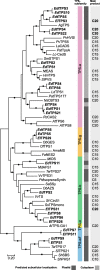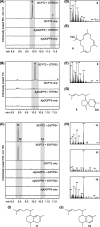Nerylneryl diphosphate is the precursor of serrulatane, viscidane and cembrane-type diterpenoids in Eremophila species
- PMID: 32111159
- PMCID: PMC7049213
- DOI: 10.1186/s12870-020-2293-x
Nerylneryl diphosphate is the precursor of serrulatane, viscidane and cembrane-type diterpenoids in Eremophila species
Abstract
Background: Eremophila R.Br. (Scrophulariaceae) is a diverse genus of plants with species distributed across semi-arid and arid Australia. It is an ecologically important genus that also holds cultural significance for many Indigenous Australians who traditionally use several species as sources of medicines. Structurally unusual diterpenoids, particularly serrulatane and viscidane-types, feature prominently in the chemical profile of many species and recent studies indicate that these compounds are responsible for much of the reported bioactivity. We have investigated the biosynthesis of diterpenoids in three species: Eremophila lucida, Eremophila drummondii and Eremophila denticulata subsp. trisulcata.
Results: In all studied species diterpenoids were localised to the leaf surface and associated with the occurrence of glandular trichomes. Trichome-enriched transcriptome databases were generated and mined for candidate terpene synthases (TPS). Four TPSs with diterpene biosynthesis activity were identified: ElTPS31 and ElTPS3 from E. lucida were found to produce (3Z,7Z,11Z)-cembratrien-15-ol and 5-hydroxyviscidane, respectively, and EdTPS22 and EdtTPS4, from E. drummondii and E. denticulata subsp. trisulcata, respectively, were found to produce 8,9-dihydroserrulat-14-ene which readily aromatized to serrulat-14-ene. In all cases, the identified TPSs used the cisoid substrate, nerylneryl diphosphate (NNPP), to form the observed products. Subsequently, cis-prenyl transferases (CPTs) capable of making NNPP were identified in each species.
Conclusions: We have elucidated two biosynthetic steps towards three of the major diterpene backbones found in this genus. Serrulatane and viscidane-type diterpenoids are promising candidates for new drug leads. The identification of an enzymatic route to their synthesis opens up the possibility of biotechnological production, making accessible a ready source of scaffolds for further modification and bioactivity testing.
Keywords: Bioactive diterpenoids; Eremophila; Plant natural products; Serrulatanes; Terpene synthase; Viscidanes; cis-prenyltransferase.
Conflict of interest statement
The authors declare that they have no competing interests.
Figures




Similar articles
-
Biodiscoveries within the Australian plant genus Eremophila based on international and interdisciplinary collaboration: results and perspectives on outstanding ethical dilemmas.Plant J. 2022 Aug;111(4):936-953. doi: 10.1111/tpj.15866. Epub 2022 Jul 23. Plant J. 2022. PMID: 35696314 Free PMC article. Review.
-
The biosynthesis of the anti-microbial diterpenoid leubethanol in Leucophyllum frutescens proceeds via an all-cis prenyl intermediate.Plant J. 2020 Nov;104(3):693-705. doi: 10.1111/tpj.14957. Epub 2020 Aug 28. Plant J. 2020. PMID: 32777127 Free PMC article.
-
Serrulatane diterpenoids with unusual side chain modifications from root bark of Eremophila longifolia.Phytochemistry. 2022 Nov;203:113408. doi: 10.1016/j.phytochem.2022.113408. Epub 2022 Sep 3. Phytochemistry. 2022. PMID: 36063865
-
Transcriptome profiling of the Australian arid-land plant Eremophila serrulata (A.DC.) Druce (Scrophulariaceae) for the identification of monoterpene synthases.Phytochemistry. 2017 Apr;136:15-22. doi: 10.1016/j.phytochem.2017.01.016. Epub 2017 Feb 3. Phytochemistry. 2017. PMID: 28162767
-
Phytochemistry, Medicinal Properties, Bioactive Compounds, and Therapeutic Potential of the Genus Eremophila (Scrophulariaceae).Molecules. 2022 Nov 10;27(22):7734. doi: 10.3390/molecules27227734. Molecules. 2022. PMID: 36431834 Free PMC article. Review.
Cited by
-
Mining coral-derived terpene synthases and mechanistic studies of the coral biflorane synthase.Sci Adv. 2025 Feb 28;11(9):eadv0805. doi: 10.1126/sciadv.adv0805. Epub 2025 Feb 26. Sci Adv. 2025. PMID: 40009671 Free PMC article.
-
Navigating through chemical space and evolutionary time across the Australian continent in plant genus Eremophila.Plant J. 2021 Oct;108(2):555-578. doi: 10.1111/tpj.15448. Epub 2021 Sep 16. Plant J. 2021. PMID: 34324744 Free PMC article.
-
Biodiscoveries within the Australian plant genus Eremophila based on international and interdisciplinary collaboration: results and perspectives on outstanding ethical dilemmas.Plant J. 2022 Aug;111(4):936-953. doi: 10.1111/tpj.15866. Epub 2022 Jul 23. Plant J. 2022. PMID: 35696314 Free PMC article. Review.
-
Alternative metabolic pathways and strategies to high-titre terpenoid production in Escherichia coli.Nat Prod Rep. 2022 Jan 26;39(1):90-118. doi: 10.1039/d1np00025j. Nat Prod Rep. 2022. PMID: 34231643 Free PMC article. Review.
-
The biosynthesis of the anti-microbial diterpenoid leubethanol in Leucophyllum frutescens proceeds via an all-cis prenyl intermediate.Plant J. 2020 Nov;104(3):693-705. doi: 10.1111/tpj.14957. Epub 2020 Aug 28. Plant J. 2020. PMID: 32777127 Free PMC article.
References
-
- Chinnock RJ. Eremophila and allied genera. A monograph of the Myoporaceae. Australia: Rosenberg Publishing; 2007.
-
- Barr A. Traditional bush medicines: an aboriginal pharmacopoeia. Richmond: Greenhouse Publications; 1988.
-
- Lassak E, McCarthy T. Australian medicinal plants: a complete guide to identification and usage. 2nd Editio. Chatswood: Reed New Holland; 2011.
-
- Hansen V, Horsfall J. Noongar bush medicine plants: medicinal plants of the south-west of Western Australia. Crawley: UWA Publishing; 2016.
-
- Isaacs J. Bush food: aboriginal food and herbal medicine. McMahons Point: Weldons; 1987.
MeSH terms
Substances
Grants and funding
LinkOut - more resources
Full Text Sources
Other Literature Sources

